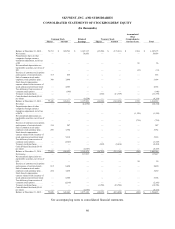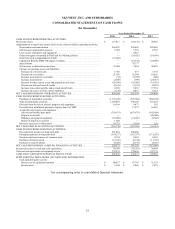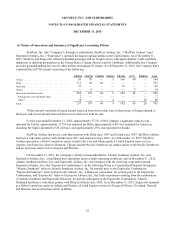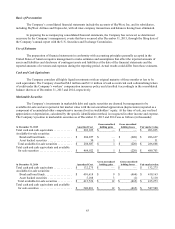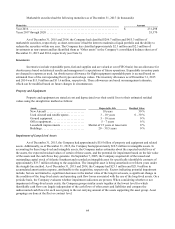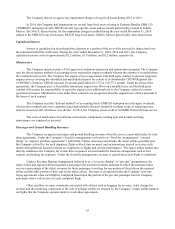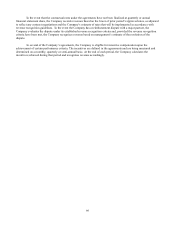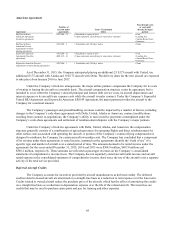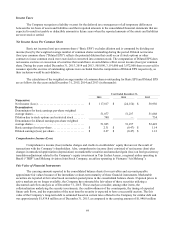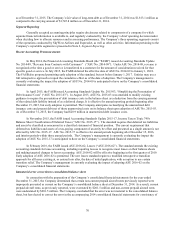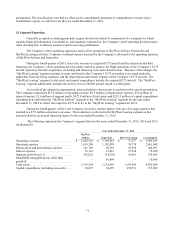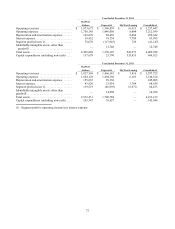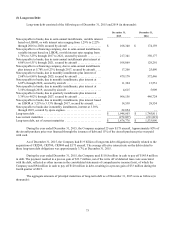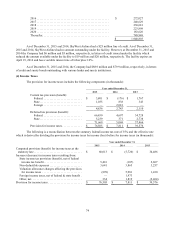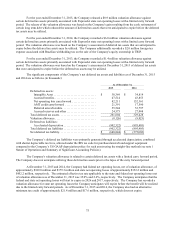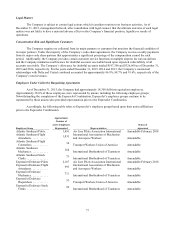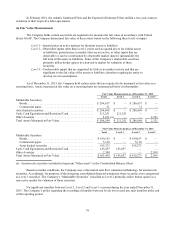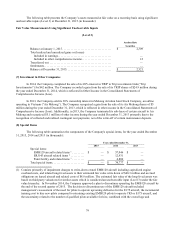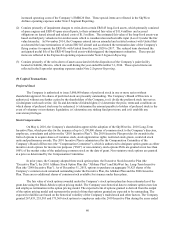SkyWest Airlines 2015 Annual Report Download - page 74
Download and view the complete annual report
Please find page 74 of the 2015 SkyWest Airlines annual report below. You can navigate through the pages in the report by either clicking on the pages listed below, or by using the keyword search tool below to find specific information within the annual report.70
as of December 31, 2015. The Company’s fair value of long-term debt as of December 31, 2014 was $1,813.1 million as
compared to the carrying amount of $1,745.8 million as of December 31, 2014.
Segment Reporting
Generally accepted accounting principles require disclosures related to components of a company for which
separate financial information is available to, and regularly evaluated by, the Company’s chief operating decision maker
when deciding how to allocate resources and in assessing performance. The Company’s three operating segments consist
of the operations conducted by SkyWest Airlines and ExpressJet, as well as other activities. Information pertaining to the
Company’s reportable segments is presented in Note 2, Segment Reporting.
Recent Accounting Pronouncements
In May 2014, the Financial Accounting Standards Board (the “FASB”) issued Accounting Standards Update
No. 2014-09, “Revenue from Contracts with Customers” (“ASU No. 2014-09”). Under ASU No. 2014-09, revenue is
recognized at the time a good or service is transferred to a customer for the amount of consideration received for that
specific good or service. In July 2015, the FASB deferred the effective date of ASU No. 2014-09 to January 1, 2018.
The FASB also proposed permitting early adoption of the standard, but not before January 1, 2017. Entities may use a
full retrospective approach or report the cumulative effect as of the date of adoption. The Company’s management is
currently evaluating the impact the adoption of ASU No. 2014-09 is anticipated to have on the Company’s consolidated
financial statements.
In April 2015, the FASB issued Accounting Standards Update No. 2015-03, “Simplifying the Presentation of
Debt Issuance Costs” (“ASU No. 2015-03”). In August 2015, ASU No. 2015-03 was amended to modify existing
guidance to require the presentation of debt issuance costs in the balance sheet as a deduction from the carrying amount
of the related debt liability instead of as a deferred charge. It is effective for annual reporting periods beginning after
December 15, 2015, but early adoption is permitted. The Company anticipates reclassifying the unamortized debt
issuance costs and present debt net of those unamortized costs on its balance sheet upon adoption of ASU No. 2015-03.
As of December 31, 2015, the Company had $20.9 million in unamortized debt issuance costs.
In November 2015, the FASB issued Accounting Standards Update 2015-17, Income Taxes (Topic 740):
Balance Sheet Classification of Deferred Taxes (“ASU No. 2015-17”). The standard requires that deferred tax liabilities
and assets be classified as noncurrent in a classified statement of financial position. The current requirement that
deferred tax liabilities and assets of a tax-paying component of an entity be offset and presented as a single amount is not
affected by ASU No. 2015-17. ASU No. 2015-17 is effective for annual periods beginning after December 15, 2016,
and interim periods within those annual periods. The Company’s management is currently evaluating the impact the
adoption of ASU No. 2015-17 is anticipated to have on the Company’s consolidated financial statements.
In February 2016, the FASB issued ASU 2016-02, Leases (“ASU 2016-02”). The standard amends the existing
accounting standards for lease accounting, including requiring lessees to recognize most leases on their balance sheets
and making targeted changes to lessor accounting. ASU 2016-02 will be effective beginning in the first quarter of 2019.
Early adoption of ASU 2016-02 is permitted. The new leases standard requires a modified retrospective transition
approach for all leases existing at, or entered into after, the date of initial application, with an option to use certain
transition relief. The Company’s management is currently evaluating the impact of adopting ASU 2016-02 on the
Company’s consolidated financial statements.
Immaterial error correction to consolidated balance sheet
In connection with the preparation of the Company’s consolidated financial statements for the year ended
December 31, 2015, the Company determined that certain non-current prepaid aircraft rents previously reported were
improperly presented as current on the Company’s consolidated balance sheet at December 31, 2014. As a result, current
prepaid aircraft rents, as previously reported, were overstated by $201.5 million and non-current prepaid aircraft rents
were understated by $201.5 million. The Company concluded that the error was not material to the consolidated balance
sheet, but has elected to correct the error in the accompanying 2014 consolidated financial statements for consistency of


